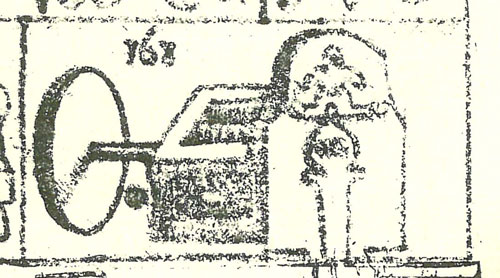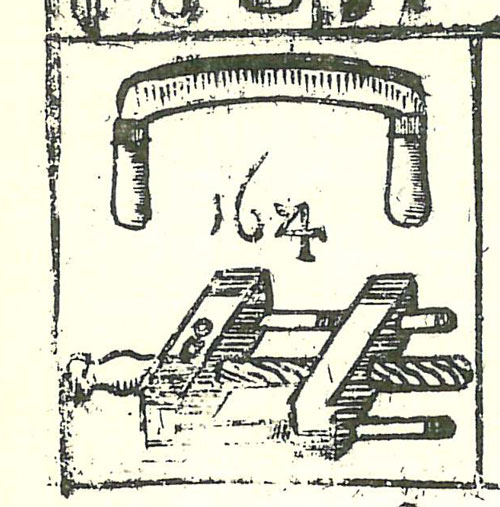
CLXIII. In this quarter is presented to your view the Head of the Turning Engine, for the turning of Oval Work, Rose Work, and Swath Work, with other kind of Work not yet named, because not found out, for no Man hath yet sought out the depth of that Instrument, or what it can or is able to perform. It hath so many parts that I know not either how to describe or tell their use; only as in other Tools I shall give you what names each Member hath, if I be rightly informed.
The parts of the Turning Engine.
The Bow, which is a strong Steel Bow fastned to the middle part of the farther side of the Puppet; having a Gut String, and to the middle of it, in a Noose is fastned another strong Gut String with a Noose at the end of it.
The Moving Collar, is an Iron Collar fastned on a Center pin on the foreside of the Puppet; this moves between the Iron Shackle and the foreside of the Puppet; though properly the Collar is only the hole in which the Axis is set. The Neck of the Collar is that part under the Shackle.
The Socket in which the Collar is moved; some term it the Shackle round hole.
The Stop Screw, which is to take out when the hollow Axis moves in the moving Collar; else it holds them together that the Collar moves not.
The Hollow Axis, which is hollow, having a shoulder on it, on which is fixed all the Guids.
The Head, or Case, or Box, in which is contained the several Guides, which is hollow, and termed the hollow in the Puppet.
The great Diameter of the Guide.
The small Diameter of the Guide.
The Axis of the Guide.
The Center head.
The Button.
The String Pulley.
The Wheel Pulley, is the Pulley to which the String comes from the Treddle Wheel, called also the Pulley of the Axis.
The Treddle Wheel.
The Guide Pulley, this is slipped to any of the Guides, as the Work-man pleaseth; it is of Brass, having a Groove in the edge of it to receive the edge of the Guide, which turning together with the assistance of the strength of the Steel Bow, forces the Guide and the Hollow Axis, to move backwards; and then an edge Tool held to the work in the Mandrell screwed in the hollow Axis, will describe the same Figure on the work, as is on the outer edge of the Guide.

CLXIV. In the chief of this quarter is the figure of a Draw Knife, an Instrument used by both Carpenter and Turner; it is a Knife with two handles turned down to the edge, much like in form to Wet Glovers Fleshing Knives, when they use it, one and off the work is set against a Wall, and the other to his Breast, and then with both hands draws Chips off the work till it be brought to their shape, and then smooth it.
S. 3 such Draw Knives A. Handle O. born by Chippering.
In the Base of this square is placed a Book-binders Plow, or cutting Knife by which the leaves of Books are cut even and smooth. It consists of these parts.
The two Stocks, one having the Knife on it, the other movable by the turning of the Screw, which hath a Groove or square hollow in the sole of it.
The two square Staves.
The Screw and Handle to turn it.
The Knife, which is held to the sole of the Stock by an Iron Pin.
The Iron Screw, and its Nut with Ears.
— From Randle Holme’s “The Academy of Armory, or, A Storehouse of Armory and Blazon” Book III, Chapter VIII, Plate 2. Why am I reading this